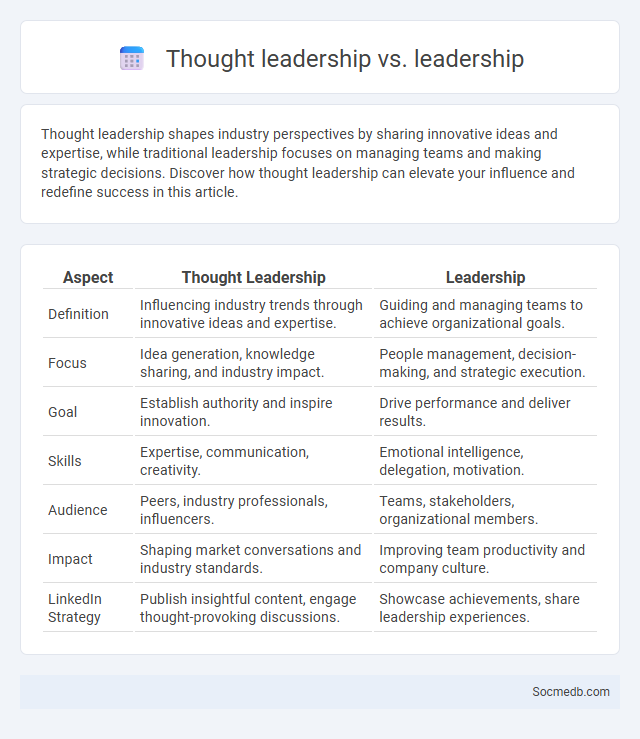
Photo illustration: Thought Leadership vs Leadership
Thought leadership shapes industry perspectives by sharing innovative ideas and expertise, while traditional leadership focuses on managing teams and making strategic decisions. Discover how thought leadership can elevate your influence and redefine success in this article.
Table of Comparison
| Aspect | Thought Leadership | Leadership |
|---|---|---|
| Definition | Influencing industry trends through innovative ideas and expertise. | Guiding and managing teams to achieve organizational goals. |
| Focus | Idea generation, knowledge sharing, and industry impact. | People management, decision-making, and strategic execution. |
| Goal | Establish authority and inspire innovation. | Drive performance and deliver results. |
| Skills | Expertise, communication, creativity. | Emotional intelligence, delegation, motivation. |
| Audience | Peers, industry professionals, influencers. | Teams, stakeholders, organizational members. |
| Impact | Shaping market conversations and industry standards. | Improving team productivity and company culture. |
| LinkedIn Strategy | Publish insightful content, engage thought-provoking discussions. | Showcase achievements, share leadership experiences. |
Defining Thought Leadership
Thought leadership in social media involves establishing authority and credibility by consistently sharing insightful, original content that addresses industry challenges and trends. Effective thought leaders leverage platforms like LinkedIn and Twitter to engage with audiences through expert opinions, research-backed posts, and innovative ideas that inspire trust and influence. Building thought leadership requires a strategic approach to content creation, audience interaction, and personal branding to position oneself as a go-to resource within a specific niche.
Understanding Traditional Leadership
Traditional leadership relies on established hierarchies and authority, emphasizing experience and cultural values to guide communities. Understanding these principles helps You navigate leadership roles within social media by respecting long-standing norms while integrating modern communication strategies. This blend fosters trust and engagement, ensuring effective influence across digital platforms.
Comparing Leadership and Thought Leadership
Leadership in social media centers on guiding teams and managing online presence, while thought leadership emphasizes sharing innovative ideas and establishing credibility within specific niches. Effective thought leaders leverage content strategy and engagement metrics to influence audience perceptions and industry trends. Measuring social media ROI differentiates impactful leadership by quantifiable brand growth against general management visibility.
The Evolution of Thought Leadership
The evolution of thought leadership on social media has transformed how experts share insights, influence opinions, and build credibility. Platforms like LinkedIn and Twitter have become pivotal for professionals to showcase innovative ideas, engage with industry peers, and establish authority in their fields. Your ability to consistently produce valuable content is crucial in standing out and driving meaningful conversations within your niche.
Key Traits of Effective Leaders
Effective leaders on social media demonstrate authenticity, consistent engagement, and clear communication, which foster trust and loyalty among followers. They leverage data analytics to tailor content strategies that resonate with diverse audiences while exhibiting empathy to address community concerns. Demonstrating accountability and adaptability enhances credibility and drives meaningful connections in the digital landscape.
Essential Qualities of Thought Leaders
Thought leaders on social media demonstrate deep expertise, authenticity, and a unique voice that resonates with their audience. They consistently share valuable insights, engage thoughtfully in conversations, and build trust through transparency and credibility. Their influence grows by fostering meaningful connections and inspiring innovation within their niche.
Leadership vs. Thought Leadership in Practice
Effective leadership on social media requires more than just authority; true thought leadership involves sharing innovative ideas and inspiring meaningful conversations that resonate with your audience. Your content should demonstrate expertise while fostering genuine connections and encouraging dialogue within your industry. By consistently providing value and insight, you establish credibility and influence beyond traditional leadership roles.
When to Emphasize Leadership or Thought Leadership
You should emphasize leadership on social media when showcasing your ability to inspire and guide teams towards achieving goals, highlighting concrete results and decision-making skills. Thought leadership is most effective when sharing unique insights, industry expertise, and innovative ideas that position you as a trusted authority in your field. Strategically balancing these approaches heightens your social media influence and strengthens your professional brand.
Building Authority: Strategies for Both Roles
Building authority on social media requires consistent content creation that showcases expertise and unique insights relevant to the target audience. Engaging with followers through thoughtful comments and responding to industry trends establishes credibility and fosters trust. Leveraging collaborations with influencers and utilizing data-driven strategies enhances visibility and solidifies a strong, authoritative presence in both personal and brand roles.
Choosing the Right Approach: Organizational Impact
Selecting the right social media strategy significantly influences organizational impact by aligning platform choices with target audience behavior and business goals. Tailored content and engagement tactics enhance brand visibility, customer loyalty, and lead generation across channels like Instagram, LinkedIn, and Twitter. Measuring performance through analytics tools enables data-driven adjustments, maximizing return on investment and overall digital presence effectiveness.
 socmedb.com
socmedb.com